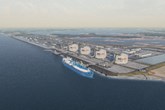PGNiG CAPEX to exceed US$8.4 billion over 2017 to 2022
Published by David Rowlands,
Editor
LNG Industry,
This will average approximately 5.7 billion zlotys per year. The firm added that almost half of this will be spent on exploration and production.
Reuters reports that the firm wants to increase its current documented hydrocarbon reserves by approximately 35%, and its hydrocarbon production by approximately 41%.
Currently, Poland, consumes approximately 16 billion m3/yr of gas, most of which is sourced from Russia (under a long-term contract with Gazprom running until 2022). Reuters claims that PGNiG is looking to secure alternative supplies after 2022.
The first LNG terminal in the country (on its Baltic coast) received its first commercial shipments in July 2016. Poland is also planning a pipeline to Norway.
The strategy has reportedly been encouraged by increasing competition in Poland’s gas market, as well as the country’s need to diversify gas imports as of 2022.
Reportedly, the company’s CAPEX programme should deliver cumulative EBITDA of 33.7 billion zlotys over the 2017 – 2022 period. PGNiG added that it expects this investment to help increase EBITDA to an average of approximately 9.2 billion zlotys per year over the 2023 – 2026 period. The company also noted that it is planning to maintain its net debt to EBITDA ratio below two, and that it would maintain its policy of paying out up to 50% of profits in dividends, but warned there could be a delay.
Read the article online at: https://www.lngindustry.com/regasification/14032017/pgnig-capex-to-exceed-us84-billion-over-2017-to-2022/
You might also like
Wood wins maintenance contract for Rio Grande LNG facility
John Wood Group PLC has secured a 10-year contract with NextDecade to deliver maintenance solutions at Rio Grande LNG in the US.

